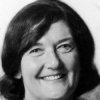Dian Fossey

Dian Fossey
Dian Fosseywas an American zoologist, primatologist, and anthropologist who undertook an extensive study of mountain gorilla groups over a period of 18 years. She studied them daily in the mountain forests of Rwanda, initially encouraged to work there by anthropologist Louis Leakey. Her 1983 book, Gorillas in the Mist, combines her scientific study of the gorillas at Karisoke Research Center with her own personal story. It was adapted into a 1988 film of the same name. Fossey was murdered in...
NationalityAmerican
ProfessionScientist
Date of Birth16 January 1932
CitySan Francisco, CA
CountryUnited States of America
When you realize the value of all life, you dwell less on what is past and concentrate more on the preservation of the future.
I feel more comfortable with gorillas than people. I can anticipate what a gorilla's going to do, and they're purely motivated.
The man who kills the animals today is the man who kills the people who get in his way tomorrow.
Active conservation [of gorillas] involves simply going out into the forest, on foot, day after day after day, attempting to capture poachers, killing-regretfully-poacher dogs, which spread rabies within the park, and cutting down traps.
I have no friends. The more you learn about the dignity of the gorilla, the more you want to avoid people.
I shall never forget my first encounter with gorillas. Sound preceded sight. Odor preceded sound in the form of an overwhelming, musky-barnyard, humanlike scent. The air was suddenly rent by a high-pitched series of screams followed by the rhythmic rondo of sharp pok-pok chestbeats from a great silverbacked male obscured behind what seemed an impenetrable wall of vegetation.
[About gorillas] You take these fine, regal animals. How many (human) fathers have the same sense of paternity? How many human mothers are more caring? The family structure is unbelievably strong.
It was their individuality combined with the shyness of their behavior that remained the most captivating impression of this first encounter with the greatest of the great apes.
There are times when one cannot accept facts for fear of shattering one's being. As I listened to Ian's news, all of Digit's life, since my first meeting with him as a playful little ball of black fluff ten years earlier, passed through my mind. From that moment on, I came to live within an insulated part of myself.
I had this great urge... I had it the day I was born. Some may call it destiny. My parents and friends called it dismaying.
The extraordinary gentleness of the adult male with his young dispels all the King Kong mythology.
Gorillas are almost altruistic in nature. There's very little if any 'me-itis.' When I get back to civilization I'm always appalled by 'me, me, me.'
One of the basic steps in saving a threatened species is to learn more about it: its diet, its mating and reproductive processes, its range patterns, its social behavior.
None of the three great apes is considered ancestral to modern man, Homo sapiens, but they remain the only other type of extant primate with which human beings share such close physical characteristics. From them we may learn much concerning the behavior of our earliest primate prototypes, because behavior, unlike bones, teeth, or tools, does not fossilize.